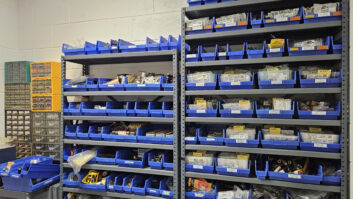The author is an AoIP network troubleshooter for Wheatstone Corp. who says most problems come when users don’t understand how different the office LAN and the AoIP network are from one another.
Leveraging current Ethernet standards and technologies, professional audio system manufacturers are able to offer broadcasters a modular digital audio routing and mixing platform that tightly integrates with automation, processing and STLs. Looking forward, emerging IEEE AVB standards, now in the final draft stages, portend to further the goal of tying all of the broadcast plant’s audio equipment into an open standards-based IP audio network.
If you are about to embark on the road to building an Ethernet audio LAN, you can gain a clear advantage by avoiding a few common potholes.
Planning
A general misconception posits that you simply connect your new networked audio devices to your office LAN.
In a broadcast plant, the need to deliver audio in an orderly, non-interrupted, deterministic stream is priority one and differs significantly from the mission of an office LAN. Moving large quantities of linear audio data over an Ethernet network is a bandwidth-intensive, real-time operation that does not tolerate disruption well.
On a conventional office LAN, disruptions of file transfers, poky printing and Internet connections, etc. are irritating. Productivity may suffer, but life goes on.

Courtesy Wheatstone Corp. Traffic problems on an audio LAN, however, are simply unacceptable. Remember that in an IP audio system, the LAN replaces the punch-block wall of audio distribution in your facility. Keep it secure and speedy by building a dedicated audio highway and limiting access only to necessary devices.
Purchasing
Some mistakes are made before the first RJ-45 connector is crimped.
When raising a modern audio network, it makes both technical and financial sense to install a Gigabit Cat-6 based system that is compatible with current hardware solutions and leaves you bandwidth headroom for growth and future technologies. Purchase quality-managed Ethernet switches, category cable, connectors and ancillary components from reputable manufacturers; this will provide the performance foundation your audio network needs and give you peace of mind.
The old adage that “you get what you pay for” certainly holds true when building an audio network. No engineer wants to tell the GM they lost revenue because of a bargain-bin patch cable.
Installation
Anyone who can crimp an RJ-45 can install a network, right?
From our experience, the greatest single source of network-related problems is related directly to the installation. The low-voltage/high-frequency nature of the electrical signals that traverse the network require a faultless signal path if they are to be transmitted and received cleanly and reliably.
Problems stem from almost every aspect of the installation: poorly crimped connectors, wrong cable type, inferior components, mixed wire maps, split pairs, broken conductors, exceeding distance limits, stretched, bent or crushed cables — you get the picture.
Installing a network cabling infrastructure is not rocket science. By following some basic rules and guidelines you can rest assured that your network will pass muster.
The TIA-568-C.0 standards document covers cabling and component requirements, structure, topologies, distances, installation, performance and testing.
Testing
Troubleshooting Ethernet networks can be a bit mysterious to the uninitiated. Maybe that is why so many networks are never fully tested.
In an analog device you can signal trace a problem with a pair of headphones and some clip leads. While you will not be able to signal trace your audio LAN with headphones or multi-meter, a variety of network test tools allow you to probe and poke the infrastructure to eliminate network segments and devices. The test tools are different; but the old divide and conquer approach still applies.
There are three levels of testing in the professional data communications cable installation world: Certification, Qualification and Verification. Each level provides a higher degree of parameter testing, with Verification being the lowest and Certification being the highest. As one might expect, the complexity of tests and the cost of required test equipment become progressively higher with each level of testing.
Every audio LAN installation should use some combination of these test methods to help get the job done quickly and correctly.
Certification testing will guarantee that the cabling system is in compliance with the TIA/EIA 568x and other industry standards. Any broadcast engineer who installs an Ethernet audio network should plan on certifying the network infrastructure prior to bringing the hardware online. Certification testing erases a huge unknown: Does the network I just installed meet the 100 or 1000BASE-T specifications? You simply don’t know until it is certified.
Qualification testing is a relatively new class of testing brought on by the availability of an innovative series of lower-cost but powerful test tools. A step lower than Certification, Qualification can be used on new or existing installations to see if certain classes or types of services will run on the installed cabling and Ethernet switches. Qualification analyzers bring bandwidth, port configuration, cable fault, length and wiremap testing together but do not run the full series of crosstalk tests that certification tools do. Qualification testers can be purchased for about $1,000.
Verification tools are essential for pre-testing all wall outlets, patch cables, horizontal runs between patch panels and equipment racks. These low-cost tools help make sure that the basic wire maps are correct before you attempt certification testing. Other tests may include shorts, opens and wire length. An integral tone generator is useful in tracing lost cables ala the “fox and hound” method. This type of tester is useful for routine testing during the initial termination phase of the build-out but by no means should this be the end of the wiring plant testing. Remember, the network you are building is the backbone of the entire IP audio system.
Documentation
Often overlooked, documentation is a fundamental step in the process of building any network. Many systems lack thorough documentation or may be poorly documented.
A well-labeled and documented Ethernet network is your best friend in a calamity. Take the time to label each cable and create a comprehensive spreadsheet with columns for wire number, source end equipment, destination end equipment, Ethernet switch port maps and IP address tables. This information is invaluable when testing, troubleshooting or adding and moving devices and cables.
Certification test equipment typically provide a means for generating compliance testing reports, usually by downloading test data collected onsite to a PC for formatting, storage and printing. Collect this data when you first install the wiring infrastructure so you have a set of data points to refer to when troubleshooting down the road.
With careful planning, the task of building a rock-solid Ethernet network for audio distribution becomes less mysterious and painful. By selecting quality components, following well-documented installation guidelines and doing rigorous testing before commissioning, you will ensure that your system speeds along, giving you more time to solve the crisis of the day.
A longer discussion, “The Role of Wiring Integrity on WheatNet-IP Network Reliability,” is available on the Wheatstone website.












